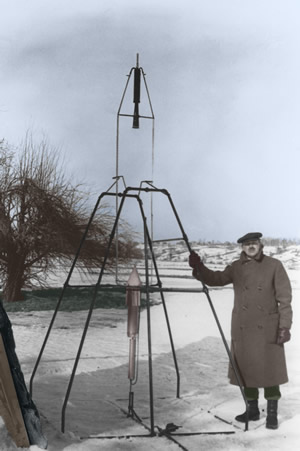Science of Conflict
Development of Rockets
Robert Goddard, pictured on the right, was a brilliant student who in 1922 obtained a Ph.D. in physics. While teaching at Clark University in Worcester, Massachusetts he developed mathematical models for spacecraft design and the mechanics of travelling beyond the earth. During the early 1920's Goddard had received funding to investigate the possibilities of liquid fuelled rocket propulsion mechanisms. His plans would later provide the initiative for the development of the V1 and V2 rockets.
In 1920 Goddard compiled a detailed scientific report into his research named " A Method for Reaching Extreme Altitudes". This paper received ridicule form sections of the media but was read with great excitement by some German rocket enthusiasts. These enthusiasts, including a young graduate named Wernher Von Braun, would eventually end up working for the Nazis arming the German army with long range weapons such as the Vi and V2 rockets.

A remarkable article criticising Goddard appeared in the editorial of the New York Times of 13 January 1920. The article is shown below.
" As a method of sending a missile to the higher, and even to the highest parts of the earth's atmosphere, Professor Goddard's rocket is practicable and therefore promising device. It is when one considers the multiple-charge (multi-stage) rocket as a traveller to the moon that one begins to doubt for after the rocket quits our air and really starts on its journey, its flight would be neither accelerated nor maintained by the explosion of the charges it then might have left. Professor Goddard with his 'chair' in Clark College and countenancing of the Smithsonian Institution, does not know the relation of action and reaction, and of the need to have something better than a vacuum against which to react. Of course he only seems to lack the knowledge ladled out daily in high schools"
What does the Editor mean by this comment? "Does not know the relation of action and reaction, and of the need to have something better than a vacuum against which to react"
Identify the scientific errors in the editorial.
How would the Editor explain the mechanism by which a blown up balloon released in mid air flies about in random motion?
Click to see a 300 Kb video of an exocet missile being launched at a target. How should the Editor explain how the missile accelerates towards its target?
Can a rocket accelerate in the vacuum of space?